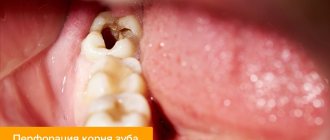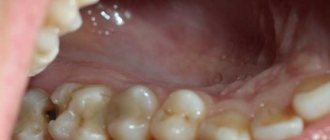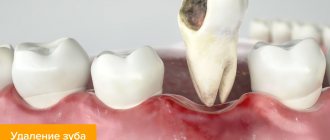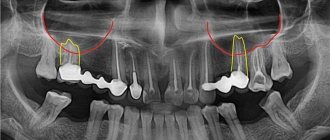Periodontitis is characterized by purulent inflammation at the apex of the root inside the gum. It develops, as a rule, as a result of pulpitis, which, in turn, is provoked by untreated caries.
As a result, it turns out that the cause of all troubles is precisely the latter disease. It is no coincidence that advertising of anti-caries products and devices is given so much screen time when watching TV.
Alternatively, the pathology becomes a consequence of suppuration in periodontal pockets. Therefore, great importance is always attached to oral hygiene.
Periodontitis has two forms: acute and chronic, with periodic exacerbations. They differ in the accompanying symptoms and the type of inflammatory process at the apex of the dental canal.
All forms of the disease are characterized by the formation of granulomas or cysts at the root tips. As they grow, they fill with pus, become inflamed, very painful and become clearly visible from the gums.
Method of root canal treatment for periodontitis
The treatment method depends on the form of the disease and the cause. There are two sources of the disease:
- advanced pulpitis;
- poor filling of tooth root canals during the treatment of pulpitis.
The cost of therapy includes:
- Anesthesia;
- Manipulations for removing old fillings;
- Treatment of root canals with extraction of contents, rinsing, filling;
- Placement of a short-term filling for the duration of treatment.
You will have to pay extra if you require mechanical treatment of the canals from a previously performed obturation, or removal of the pin. Installation of a permanent filling is also paid separately.
The cost of getting rid of periodontitis is determined by the number of root canals in the teeth. It is known that canines and incisors are equipped with a single root. In molars and premolars, the number of roots varies, and in the upper teeth there are often more of them - up to four.
Stages of treatment of chronic periodontitis
Periodontitis of any form means that the tissue at the apex of the root canal is modified in an unnatural way.
With chronic damage, three characteristic types of the disease are distinguished:
- Fibrous;
- Granulating;
- Granulomatous.
The doctor determines the nature of the pathology by the accompanying symptoms. Additional instrumental studies are included, including percussion, canal probing and x-rays.
The fibrous type of periodontitis is uncommon. With this type, at the apical apex of the root, as a rule, there are no obvious abscesses with the discharge of pus and cardinal changes in the gums. Therefore, treatment is carried out in two visits. At the first appointment, the doctor treats and disinfects the canals, and at the second, he places a permanent filling.
The other two modifications require long-term treatment, sometimes up to a month, in four visits. This is due to massive purulent accumulations in the gum and area near the bone. The doctor here has to act thoughtfully and carefully, trying to save the tooth without harming the patient.
Let's consider an example of step-by-step treatment of granulating or granulomatous periodontitis in an adult.
What is perforation and its types
Perforation refers to tooth pathology, which manifests itself as a hole in the dental tissue that flows into the tooth cavity. A phenomenon such as perforation is rare, but the defect is quite serious and requires mandatory treatment. Depending on the location, the following types of perforation are distinguished:
- Bottom of the tooth cavity. This type of perforation is observed when the dental axis is displaced and can develop against the background of abrasion of the tooth surface. More often, the development of such perforation is caused by a strong expansion of the dental cavity, which can form during the treatment process.
- Tooth root. This type of perforation is the most common and requires immediate treatment, as it can cause the development of a destructive process in the periodontium. One of the main factors for perforation is incorrectly positioned or twisted roots. To find out the location of the hole in the canal, an x-ray is performed.
- Walls of the tooth. The formation of perforation in the area of the dental walls is caused by improper manipulations by the dentist. Its manifestation is the result of inaccurate strong impact on the tooth during its treatment. This pathology can be detected immediately, as gum bleeding and pain appear.
Depending on the time of manifestation of perforation, it can be fresh - it appears immediately after formation, and old, when the pathology has no symptoms for a long time, it becomes the cause of infection of dental tissues. If the defect is not corrected in time, the affected segment of the tooth, as well as the tooth as a whole, may be lost.
First visit
- When a patient comes to the dentist with complaints and the doctor suspects periodontitis, an X-ray examination of the jaw is initially performed to identify the source of pain.
- Then, under anesthesia, the doctor uses a drill to remove carious tissue and open access to the mouths of the tooth tubules. At the same time, the affected pulp is removed and, if necessary, the filling material previously placed there is drilled out of the canals.
- The length of the root canals is certainly measured - using a special device or directly on an x-ray.
- The channels are mechanically expanded and filled with turundums soaked in antiseptic. Without preliminary treatment, it will be difficult for the doctor to properly fill the canal to the very top. Doctors prefer to use Crezofen or its cheaper analogues as a disinfectant. The product does not contain arsenic, does not irritate locally, and is approved for the treatment of pregnant women.
- After all the manipulations, a temporary filling is installed, and the patient goes home. If the dentist deems it necessary, the patient is prescribed anti-inflammatory drugs and medications to prevent the development of allergic reactions. If the form of periodontitis is chronic, antibiotics will not be required.
Diagnostic methods
Diagnosis of tooth perforation is based on patient complaints and visual examination of the oral cavity. In most cases, perforation in the crowns of teeth can be recognized using an x-ray. If there is a suspicion of perforation localized in the area of the bottom of the dental cavity, an X-ray with contrast is performed. In any case, an image is taken that allows you to determine not only the presence of perforation, but also to identify complications caused by the pathology.
When holes form in the dental canal, additional equipment and tools are required to identify them. It is easier to diagnose perforation when there are already symptoms: sharp pain, mild bleeding, changes in the movement of the instrument during dental treatment.
With old perforation formed in the canal, symptoms appear, which in their manifestations resemble periodontitis. It is diagnosed along with inflammation, which affects the tissues located near the roots of the teeth. In the presence of such perforation of dental units, characteristic pain in the tooth is observed, which appears when pressing on the damaged segment, swelling of the gums, concentrated in the area of inflammation.
Tooth perforation, localized in the root of the teeth, is diagnosed using a paper pin by immersing it in the canal. The location of the perforation is determined by the trace of blood that remains on the paper.
Second visit
After a couple of days, the doctor at the appointment assesses the patient’s condition - whether there are any swellings, whether the temperature has risen, whether the lymph nodes are inflamed, etc.
If no complaints are received, the doctor removes the temporary filling and turundas with cresophen, and then obturation of the root canals with temporary filling material. Its task is to help the bone tissue partially regenerate in the place where the inflammatory process was noted at the root apex. In addition, the substance sanitizes and disinfects the tubule cavity. Calcium hydroxide-based pastes are mainly used as temporary fillings: Calasept, Metapex.
From above, all this is covered with a new non-permanent filling.
Temporary filling
In some cases, medicine is introduced into the canals for a certain period of time. Manipulation is carried out for:
- elimination of pathological microflora;
- stopping the inflammatory process;
- isolation of the canal, when it is impossible to carry out treatment in one visit.
Indications for temporary installation of a filling are injuries, perforation of walls, periodontitis in acute or chronic form.
The main active components of medicinal non-hardening pastes are antibiotics.
Third visit
In addition to a visual examination, the doctor will need an x-ray to examine the quality of the therapy and make sure that the abscess is not growing. Having seen a positive result with traces of bone restoration, the doctor either proceeds to install permanent fillings or decides to continue treatment.
If the outcome is favorable, the dentist cleans the tubules from the substrate that temporarily fills them, rinses, disinfects and carefully seals with gutta-percha to the very top.
Finally, an x-ray is taken to show how well the tooth canals are filled. If the filling material extends beyond the apex or does not reach it, the doctor's work was in vain. The channels will have to be redone. In the opposite case, periodontitis recurs with the same force.
A temporary filling is placed for the third time.
Treatment of acute periodontitis and exacerbation of chronic
These forms of the disease are characterized by concomitant severe inflammation in the gums and the development of suppuration. The patient is in pain. If the situation is ignored, it sometimes leads to swelling of the soft tissues of the face and a rise in temperature.
Such symptoms should be treated urgently. When a person goes to the hospital, the doctor identifies an exacerbation of chronic or diagnoses acute periodontitis and performs an autopsy of the tooth. This way, the pus leaves the root canals, and the patient feels better.
If the abscess has spread further into the tissues of the mouth, even into the cheeks, the dentist will cut the gum.
After the operation, fillings are not placed and the treatment steps described above are not applied. The patient lives for several days with an open tooth or accessible canals to ensure the outflow of pathological contents. While eating, the tooth is closed with a cotton ball, then opens again. The main thing for the patient is to prevent pieces of food from getting into uncovered cavities, avoiding re-inflammation.
In a paid clinic, the mentioned procedures are performed at the patient’s expense; the cost depends on the rating of the institution and the category of the doctor. Usually - in the range of 2000-2500 rubles.
When visiting a hospital at the place of residence with an insurance policy and passport, the patient has the right to count on free medical care.
Doctor's orders during therapy
At the beginning of treatment of periodontitis, a specific medicine such as Crezofen, which is considered an excellent antiseptic, is usually placed inside the opened tooth canals.
Additionally, rinses with Miramistin or analogues are prescribed, a drug against the development of allergic reactions (Suprastin, for example) and an anesthetic are suggested.
If necessary, the doctor prescribes antibiotics if he sees that the situation is advanced and almost borders on sepsis. A locally acting antibiotic like Lincomycin, which is routinely preferred by dentists, is not suitable here. You will need weapons of mass destruction of bacterial microflora - Ciprofloxacin, Augmentin, Amoxicillin, etc.
If the patient experiences undesirable changes in health status or increased pain, it is recommended not to delay going to the hospital.
In case of exacerbations of chronic periodontitis, when the acute picture of the disease is leveled, therapy involves the installation of temporary fillings in the root canals. This is both obstruction and treatment at the same time. Calcium hydroxide, which is part of the filling material, acts as the basis for the regeneration of bone tissue in the area of inflammation. This procedure takes up to 90 days and all this time a temporary filling in the canal promotes healing of the affected area.
Such conservative therapy for small granulomas becomes a great help for the doctor in healing the disease and allows, in most cases, to avoid traumatic surgery. However, intervention cannot be avoided if the diameter of the cyst exceeds one and a half centimeters. It is not possible to heal formations of this size in a gentle way.
The dangers of treating periodontitis at home
The desire of some people to avoid visiting the dental office by any means and continue to endure pain cannot be explained. At the same time, patients persistently practice self-medication, search for recipes on the Internet, rinse their mouths with herbs and smear their sore teeth with homemade compounds of dubious content.
Unfortunately, none of the diseases mentioned in the article can be treated at home. Any method that has been proven over the years, which refers to grandmother’s recipes, will not heal, but will only ease the pain and help the outflow of purulent contents. Remember, the use of this or that non-traditional method of treatment must obtain the approval of a doctor.
Painkillers are also only allowed in limited quantities. Many drugs have a strong and negative effect on the liver and gastrointestinal tract. Therefore, it is unacceptable to constantly relieve pain with pills. And heating a sore tooth, trying to reduce the level of discomfort, is strictly prohibited!
Taking self-prescribed antibiotics will not be successful, because the drug is not able to penetrate into the root canals. It will also not be possible to disinfect and eliminate the source of inflammation by rinsing your mouth. In addition to the warnings voiced, let us remind you that the pathogenic microflora of carious tissues is extremely resistant to drugs, so it cannot be destroyed by taking drugs; drilling is required.
It is better to direct all unspent energy to the prevention of dental diseases. Choosing the right toothbrush, getting into the habit of flossing, and getting regular professional teeth cleanings at your doctor's office are the foundations of oral health.
Root canal treatment for chronic periodontitis
Cervical caries on the front teeth: causes and treatment
Retreatment of tooth canals before prosthetics, with granuloma, cyst and aching pain
Treatment of dental caries using the Icon method without preparation
Dental treatment without pain in Moscow
Treatment of pericoronitis of the wisdom tooth in the lower jaw
Dental treatment during pregnancy 2nd trimester
Symptoms of pathology
In the first stages of perforation development, symptoms are absent or mild, so the patient does not consult a specialist. Pronounced symptoms appear as a result of complications of perforation. In rare cases, signs of a problem can be recognized in the early stages. These include:
- the appearance of sharp pain in the oral cavity;
- swelling, redness, inflammation of the gums;
- headaches and weakness;
- bleeding that appears from the resulting wound;
- periodic aching pain (with old perforation).
The difficulty in identifying perforation is due to the fact that it cannot be recognized visually. The formation of a cavity in the dental canal in the root area occurs within the structure of the teeth. Sometimes the dentist can immediately detect the formation of a perforation when the position of the instrument in the canal changes suddenly.











